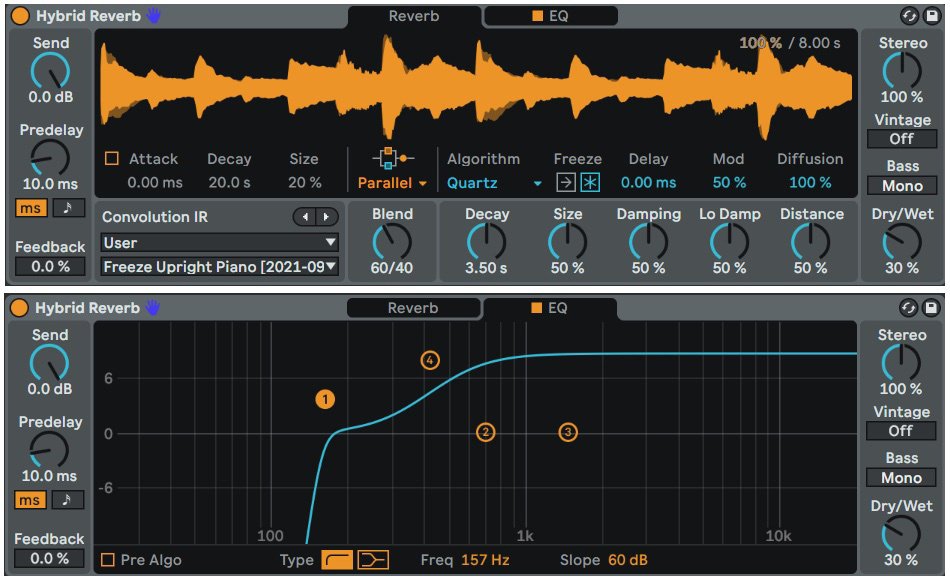Exploring the Creative Potential of Ableton's Hybrid Reverb Effect
Hybrid Reverb is a powerful tool that combines convolution and algorithmic reverb techniques to create immersive and unique sonic spaces.
Understanding Hybrid Reverb
The Hybrid Reverb in Ableton is a fusion of Convolution and Algorithmic Reverb. Convolution reverb captures real acoustic spaces by using impulse responses (IRs) while Algorithmic reverb generates artificial reverberation based on mathematical algorithms. This amalgamation allows for unparalleled flexibility and creativity in sculpting reverbs.
Interface and Controls
The Hybrid Reverb interface in Ableton Live features intuitive controls that facilitate precise manipulation of the reverb effect:
IR Section: This section allows loading custom or pre-installed impulse responses, enabling the recreation of real-world spaces like halls, rooms, or unconventional environments.
Algorithm Section: It provides various algorithms to craft synthetic reverbs, offering control over parameters such as decay, diffusion, modulation, and more.
Blend and EQ Controls: The Blend knob lets you mix between the Convolution and Algorithmic reverbs, while EQ parameters enable shaping the reverb's tonal characteristics.
How to Use the Hybrid Reverb Effect
1. Loading Impulse Responses
Start by exploring and loading impulse responses. Experiment with different IRs to emulate diverse spaces. Adjust the IR section's parameters such as size, shape, and stereo width to tailor the reverb to your liking.
2. Manipulating Algorithmic Reverb
Experiment with the algorithmic section to craft artificial reverbs. Tweak parameters like decay, diffusion, modulation, and density to design unique and otherworldly reverberations.
3. Blending Convolution and Algorithmic Reverbs
Use the Blend knob to blend between the Convolution and Algorithmic reverbs. Find the perfect balance that suits your track, blending the realism of convolution with the versatility of algorithmic reverb.
4. Shaping the Reverb's Tone
Utilize the EQ controls to sculpt the reverb's tonality. Adjusting the high and low frequencies can help the reverb sit better in the mix and create specific sonic textures.
5. Automating Parameters
Experiment with automation to modulate various parameters over time. Automating decay, modulation, or blend can add movement and dynamics to your track, enhancing its depth and character.
Creative Applications
Sound Design: Use the Hybrid Reverb to create unique soundscapes, atmospheric textures, and unconventional sonic environments, perfect for film scoring or experimental music.
Mixing and Production: Apply the Hybrid Reverb to add depth and spaciousness to instruments, vocals, or entire mixes. It can contribute to the overall ambience and cohesiveness of a track.
Conclusion
Ableton Live's Hybrid Reverb is a versatile and powerful tool that empowers producers and sound designers to explore endless sonic possibilities. By combining the realism of convolution with the flexibility of algorithmic reverb, it opens doors to creative experimentation and refined control over spatial effects in music production.
Experimentation is key to unlocking the full potential of the Hybrid Reverb. By delving into its various parameters and functionalities, producers can elevate their tracks with captivating and immersive reverberations that captivate listeners and elevate the sonic experience.
The Hybrid Reverb in Ableton Live is a playground for sonic exploration, offering a rich palette of reverberations and spatial effects. Incorporating its functionalities can truly enhance the depth and immersion of your music productions.



